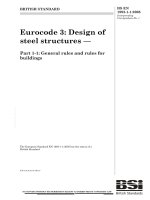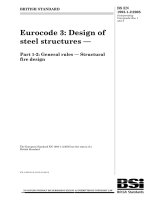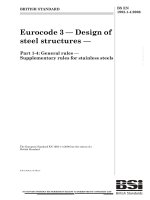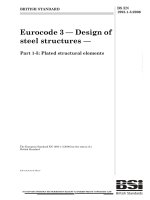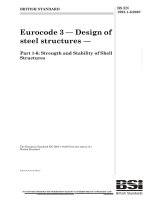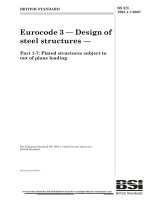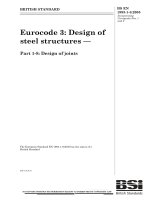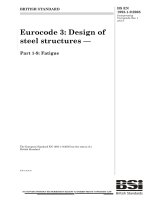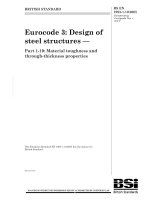Tiêu chuẩn Châu Âu EC5: Kết cấu gỗ phần 1.1: Quy định chung (Eurocode5 BS EN1995 1 1 e 2004 Design of timber structures part 1.1: General rules and rules for building)
Bạn đang xem bản rút gọn của tài liệu. Xem và tải ngay bản đầy đủ của tài liệu tại đây (2.12 MB, 128 trang )
BS EN
1995-1-1:2004
BRITISH STANDARD
Eurocode 5: Design of
timber structures —
Part 1-1: General — Common rules and
rules for buildings
--`,`,,,`,``,,,```````,,`,,`,,-`-`,,`,,`,`,,`---
The European Standard EN 1995-1-1:2004 has the status of a
British Standard
ICS 91.010.30; 91.080.20
12 &23<,1* :,7+287 %6, 3(50,66,21 (;&(37 $6 3(50,77(' %< &23<5,*+7 /$:
Copyright European Committee for Standardization
Provided by IHS under license with CEN
No reproduction or networking permitted without license from IHS
Licensee=Politecnico Milano/5935522004
Not for Resale, 03/13/2006 07:10:10 MST
BS EN 1995-1-1:2004
National foreword
This British Standard is the official English language version of
EN 1995-1-1:2004. It supersedes DD ENV 1995-1-1:1994 which is withdrawn.
The structural Eurocodes are divided into packages by grouping Eurocodes for
each of the main materials, concrete, steel, composite concrete and steel,
timber, masonry and aluminium, which is to enable a common date of
withdrawal (DOW) for all the relevant parts that are needed for a particular
design. The conflicting national standards will be withdrawn at the end of the
coexistence period, after all the EN Eurocodes of a package are available.
Following publication of the EN, there is a period of 2 years allowed for the
national calibration period during which the National Annex is issued,
followed by a three year coexistence period. During the coexistence period
Member States will be encouraged to adapt their national provisions to
withdraw conflicting national rules before the end of the coexistent period. The
Commission in consultation with Member States is expected to agree the end
of the coexistence period for each package of Eurocodes.
At the end of this coexistence period, the national standard(s) will be
withdrawn.
In the UK, the corresponding national standards are:
This British Standard, was
published under the authority
of the Standards Policy and
Strategy Committee on
15 December 2004
— BS 5268-2:2002, Structural use of timber — Part 2: Code of practice for
permissible stress design, materials and workmanship;
— BS 5268-3:1998, Structural use of timber — Part 3: Code of practice for
trussed rafter roofs;
— BS 5268-6.1:1996, Structural use of timber — Part 6: Code of practice for
timber frame walls — Section 6.1: Dwellings not exceeding four storeys;
— BS 5268-6.2:2002, Structural use of timber — Part 6: Code of practice for
timber frame walls — Section 6.2: Buildings other than dwellings not
exceeding four storeys;
— BS 5268-7.1:1989, Structural use of timber — Part 7: Recommendations
for the calculation basis for span tables — Section 7.1: Domestic floor joists;
— BS 5268-7.2:1989, Structural use of timber — Part 7: Recommendations
for the calculation basis for span tables — Section 7.2: Joists for flat roofs;
— BS 5268-7.3:1989, Structural use of timber — Part 7: Recommendations
for the calculation basis for span tables — Section 7.3: Ceiling joists;
— BS 5268-7.4:1989, Structural use of timber — Part 7: Recommendations
for the calculation basis for span tables — Part 7.4: Ceiling binders;
— BS 5268-7.5:1990, Structural use of timber — Part 7: Recommendations
for the calculation basis for span tables — Section 7.5: Domestic rafters;
— BS 5268-7.6:1990, Structural use of timber — Part 7: Recommendations
for the calculation basis for span tables — Section 7.6: Purlins supporting
rafters;
— BS 5268-7.7:1990, Structural use of timber — Part 7: Recommendations
for the calculation basis for span tables — Section 7.7: Purlins supporting
sheeting or decking;
and based on this transition period, these standards will be withdrawn on a
date to be announced.
© BSI 15 December 2004
Amendments issued since publication
Amd. No.
Date
Comments
ISBN 0 580 45147 X
--`,`,,,`,``,,,```````,,`,,`,,-`-`,,`,,`,`,,`---
Copyright European Committee for Standardization
Provided by IHS under license with CEN
No reproduction or networking permitted without license from IHS
Licensee=Politecnico Milano/5935522004
Not for Resale, 03/13/2006 07:10:10 MST
BS EN 1995-1-1:2004
The UK participation in its preparation was entrusted by Technical Committee
B/525, Building and civil engineering structures, to Subcommittee B/525/5,
Structural use of timber, which has the responsibility to:
—
aid enquirers to understand the text;
—
present to the responsible international/European committee any
enquiries on the interpretation, or proposals for change, and keep the
UK interests informed;
—
monitor related international and European developments and
promulgate them in the UK.
A list of organizations represented on this subcommittee can be obtained on
request to its secretary.
Where a normative part of this EN allows for a choice to be made at the national
level, the range and possible choice will be given in the normative text, and a note
will qualify it as a Nationally Determined Parameter (NDP). NDPs can be a
specific value for a factor, a specific level or class, a particular method or a
particular application rule if several are proposed in the EN.
To enable EN 1995-1-1 to be used in the UK, the NDPs will be published in a
National Annex, which will be made available by BSI in due course, after public
consultation has taken place.
Cross-references
The British Standards which implement international or European publications
referred to in this document may be found in the BSI Catalogue under the section
entitled “International Standards Correspondence Index”, or by using the
“Search” facility of the BSI Electronic Catalogue or of British Standards Online.
This publication does not purport to include all the necessary provisions of a
contract. Users are responsible for its correct application.
Compliance with a British Standard does not of itself confer immunity
from legal obligations.
Summary of pages
This document comprises a front cover, an inside front cover, page i and ii, the
EN title page, pages 2 to 123 and a back cover.
The BSI copyright notice displayed in this document indicates when the
document was last issued.
--`,`,,,`,``,,,```````,,`,,`,,-`-`,,`,,`,`,,`---
Copyright European Committee for Standardization
Provided by IHS under license with CEN
No reproduction or networking permitted without license from IHS
i
Licensee=Politecnico Milano/5935522004
Not for Resale, 03/13/2006 07:10:10 MST
--`,`,,,`,``,,,```````,,`,,`,,-`-`,,`,,`,`,,`---
ii
Copyright European Committee for Standardization
Provided by IHS under license with CEN
No reproduction or networking permitted without license from IHS
blank
Licensee=Politecnico Milano/5935522004
Not for Resale, 03/13/2006 07:10:10 MST
EN 1995-1-1
EUROPEAN STANDARD
NORME EUROPÉENNE
EUROPÄISCHE NORM
November 2004
ICS 91.010.30; 91.080.20
Supersedes ENV 1995-1-1:1993
English version
Eurocode 5: Design of timber structures - Part 1-1: General Common rules and rules for buildings
Eurocode 5: Conception et calcul des structures en bois Partie 1-1 : Généralités - Règles communes et règles pour
les bâtiments
Eurocode 5: Bemessung und Konstruktion von Holzbauten
- Teil 1-1: Allgemeines - Allgemeine Regeln und Regeln für
den Hochbau
This European Standard was approved by CEN on 16 April 2004.
CEN members are bound to comply with the CEN/CENELEC Internal Regulations which stipulate the conditions for giving this European
Standard the status of a national standard without any alteration. Up-to-date lists and bibliographical references concerning such national
standards may be obtained on application to the Central Secretariat or to any CEN member.
This European Standard exists in three official versions (English, French, German). A version in any other language made by translation
under the responsibility of a CEN member into its own language and notified to the Central Secretariat has the same status as the official
versions.
CEN members are the national standards bodies of Austria, Belgium, Cyprus, Czech Republic, Denmark, Estonia, Finland, France,
Germany, Greece, Hungary, Iceland, Ireland, Italy, Latvia, Lithuania, Luxembourg, Malta, Netherlands, Norway, Poland, Portugal, Slovakia,
Slovenia, Spain, Sweden, Switzerland and United Kingdom.
EUROPEAN COMMITTEE FOR STANDARDIZATION
COMITÉ EUROPÉEN DE NORMALISATION
EUROPÄISCHES KOMITEE FÜR NORMUNG
Management Centre: rue de Stassart, 36
© 2004 CEN
B-1050 Brussels
All rights of exploitation in any form and by any means reserved
worldwide for CEN national Members.
--`,`,,,`,``,,,```````,,`,,`,,-`-`,,`,,`,`,,`---
Copyright European Committee for Standardization
Provided by IHS under license with CEN
No reproduction or networking permitted without license from IHS
Licensee=Politecnico Milano/5935522004
Not for Resale, 03/13/2006 07:10:10 MST
Ref. No. EN 1995-1-1:2004: E
EN 1995-1-1:2004 (E)
Contents
Page
Foreword
7
GENERAL
10
1.1
SCOPE
1.1.1
Scope of EN 1995
1.1.2
Scope of EN 1995-1-1
1.2
NORMATIVE REFERENCES
1.3
ASSUMPTIONS
1.4
DISTINCTION BETWEEN PRINCIPLES AND APPLICATION RULES
1.5
TERMS AND DEFINITIONS
1.5.1
General
1.5.2
Additional terms and definitions used in this present standard
1.6
SYMBOLS USED IN EN 1995-1-1
SECTION 2
BASIS OF DESIGN
19
2.1
REQUIREMENTS
2.1.1
Basic requirements
2.1.2
Reliability management
2.1.3
Design working life and durability
2.2
PRINCIPLES OF LIMIT STATE DESIGN
2.2.1
General
2.2.2
Ultimate limit states
2.2.3
Serviceability limit states
2.3
BASIC VARIABLES
2.3.1
Actions and environmental influences
2.3.1.1
2.3.1.2
2.3.1.3
2.3.2
General
Load-duration classes
Service classes
22
Load-duration and moisture influences on strength
Load-duration and moisture influences on deformations
2.4
VERIFICATION BY THE PARTIAL FACTOR METHOD
2.4.1
Design value of material property
2.4.2
Design value of geometrical data
2.4.3
Design resistances
2.4.4
Verification of equilibrium (EQU)
SECTION 3
MATERIAL PROPERTIES
4.1
4.2
5.1
DURABILITY
26
26
26
26
26
26
27
28
29
29
29
30
30
BASIS OF STRUCTURAL ANALYSIS
GENERAL
31
31
2
Copyright European Committee for Standardization
Provided by IHS under license with CEN
No reproduction or networking permitted without license from IHS
24
24
25
25
25
30
RESISTANCE TO BIOLOGICAL ORGANISMS
RESISTANCE TO CORROSION
SECTION 5
22
22
26
3.1
GENERAL
3.1.1
Strength and stiffness parameters
3.1.2
Stress-strain relations
3.1.3
Strength modification factors for service classes and load-duration classes
3.1.4
Deformation modification factors for service classes
3.2
SOLID TIMBER
3.3
GLUED LAMINATED TIMBER
3.4
LAMINATED VENEER LUMBER (LVL)
3.5
WOOD-BASED PANELS
3.6
ADHESIVES
3.7
METAL FASTENERS
SECTION 4
19
19
19
19
19
19
19
20
21
21
21
21
22
Materials and product properties
2.3.2.1
2.3.2.2
10
10
10
11
13
13
13
13
13
14
Licensee=Politecnico Milano/5935522004
Not for Resale, 03/13/2006 07:10:10 MST
--`,`,,,`,``,,,```````,,`,,`,,-`-`,,`,,`,`,,`---
SECTION 1
EN 1995-1-1:2004 (E)
5.2
MEMBERS
5.3
CONNECTIONS
5.4
ASSEMBLIES
5.4.1
General
5.4.2
Frame structures
5.4.3
Simplified analysis of trusses with punched metal plate fasteners
5.4.4
Plane frames and arches
SECTION 6
ULTIMATE LIMIT STATES
31
31
32
32
32
33
34
36
--`,`,,,`,``,,,```````,,`,,`,,-`-`,,`,,`,`,,`---
6.1
DESIGN OF CROSS-SECTIONS SUBJECTED TO STRESS IN ONE PRINCIPAL DIRECTION
36
6.1.1
General
36
6.1.2
Tension parallel to the grain
36
6.1.3
Tension perpendicular to the grain
36
6.1.4
Compression parallel to the grain
36
6.1.5
Compression perpendicular to the grain
36
6.1.6
Bending
41
6.1.7
Shear
41
6.1.8
Torsion
42
6.2
DESIGN OF CROSS-SECTIONS SUBJECTED TO COMBINED STRESSES
43
6.2.1
General
43
6.2.2
Compression stresses at an angle to the grain
43
6.2.3
Combined bending and axial tension
43
6.2.4
Combined bending and axial compression
43
6.3
STABILITY OF MEMBERS
44
6.3.1
General
44
6.3.2
Columns subjected to either compression or combined compression and bending44
6.3.3
Beams subjected to either bending or combined bending and compression
45
6.4
DESIGN OF CROSS-SECTIONS IN MEMBERS WITH VARYING CROSS-SECTION OR CURVED
SHAPE 47
6.4.1
General
47
6.4.2
Single tapered beams
47
6.4.3
Double tapered, curved and pitched cambered beams
48
6.5
NOTCHED MEMBERS
52
6.5.1
General
52
6.5.2
Beams with a notch at the support
52
6.6
SYSTEM STRENGTH
53
SECTION 7
SERVICEABILITY LIMIT STATES
7.1
JOINT SLIP
7.2
LIMITING VALUES FOR DEFLECTIONS OF BEAMS
7.3
VIBRATIONS
7.3.1
General
7.3.2
Vibrations from machinery
7.3.3
Residential floors
SECTION 8
CONNECTIONS WITH METAL FASTENERS
8.1
GENERAL
8.1.1
Fastener requirements
8.1.2
Multiple fastener connections
8.1.3
Multiple shear plane connections
8.1.4
Connection forces at an angle to the grain
8.1.5
Alternating connection forces
8.2
LATERAL LOAD-CARRYING CAPACITY OF METAL DOWEL-TYPE FASTENERS
8.2.1
General
8.2.2
Timber-to-timber and panel-to-timber connections
8.2.3
Steel-to-timber connections
8.3
NAILED CONNECTIONS
8.3.1
Laterally loaded nails
55
55
55
56
56
56
56
59
59
59
59
59
59
61
61
61
61
63
65
65
3
Copyright European Committee for Standardization
Provided by IHS under license with CEN
No reproduction or networking permitted without license from IHS
Licensee=Politecnico Milano/5935522004
Not for Resale, 03/13/2006 07:10:10 MST
EN 1995-1-1:2004 (E)
General
Nailed timber-to-timber connections
Nailed panel-to-timber connections
Nailed steel-to-timber connections
8.3.2
Axially loaded nails
8.3.3
Combined laterally and axially loaded nails
8.4
STAPLED CONNECTIONS
8.5
BOLTED CONNECTIONS
8.5.1
Laterally loaded bolts
8.5.1.1
8.5.1.2
8.5.1.3
General and bolted timber-to-timber connections
Bolted panel-to-timber connections
Bolted steel-to-timber connections
8.5.2
Axially loaded bolts
8.6
DOWELLED CONNECTIONS
8.7
SCREWED CONNECTIONS
8.7.1
Laterally loaded screws
8.7.2
Axially loaded screws
8.7.3
Combined laterally and axially loaded screws
8.8
CONNECTIONS MADE WITH PUNCHED METAL PLATE FASTENERS
8.8.1
General
8.8.2
Plate geometry
8.8.3
Plate strength properties
8.8.4
Plate anchorage strengths
8.8.5
Connection strength verification
8.8.5.1
8.8.5.2
8.9
8.10
Plate anchorage capacity
Plate capacity
COMPONENTS AND ASSEMBLIES
9.1
COMPONENTS
9.1.1
Glued thin-webbed beams
9.1.2
Glued thin-flanged beams
9.1.3
Mechanically jointed beams
9.1.4
Mechanically jointed and glued columns
9.2
ASSEMBLIES
9.2.1
Trusses
9.2.2
Trusses with punched metal plate fasteners
9.2.3
Roof and floor diaphragms
9.2.3.1
9.2.3.2
9.2.4
70
72
72
74
74
74
75
76
76
76
77
77
77
78
78
78
78
79
80
80
80
82
SPLIT RING AND SHEAR PLATE CONNECTORS
TOOTHED-PLATE CONNECTORS
SECTION 9
65
67
70
70
General
Simplified analysis of roof and floor diaphragms.
Wall diaphragms
83
86
89
89
89
91
92
93
93
93
94
95
95
95
96
9.2.4.1
General
96
9.2.4.2
Simplified analysis of wall diaphragms – Method A
96
9.2.4.3
Simplified analysis of wall diaphragms – Method B
99
9.2.4.3.1 Construction of walls and panels to meet the requirements of the simplified analysis99
9.2.4.3.2 Design procedure
100
9.2.5
Bracing
9.2.5.1
9.2.5.2
9.2.5.3
102
General
Single members in compression
Bracing of beam or truss systems
102
102
103
SECTION 10 STRUCTURAL DETAILING AND CONTROL
10.1 GENERAL
10.2 MATERIALS
10.3 GLUED JOINTS
10.4 CONNECTIONS WITH MECHANICAL FASTENERS
10.4.1
General
10.4.2
Nails
10.4.3
Bolts and washers
4
Copyright European Committee for Standardization
Provided by IHS under license with CEN
No reproduction or networking permitted without license from IHS
Licensee=Politecnico Milano/5935522004
Not for Resale, 03/13/2006 07:10:10 MST
105
105
105
105
105
105
105
105
--`,`,,,`,``,,,```````,,`,,`,,-`-`,,`,,`,`,,`---
8.3.1.1
8.3.1.2
8.3.1.3
8.3.1.4
EN 1995-1-1:2004 (E)
10.4.4
Dowels
10.4.5
Screws
10.5 ASSEMBLY
10.6 TRANSPORTATION AND ERECTION
10.7 CONTROL
10.8 SPECIAL RULES FOR DIAPHRAGM STRUCTURES
10.8.1
Floor and roof diaphragms
10.8.2
Wall diaphragms
10.9 SPECIAL RULES FOR TRUSSES WITH PUNCHED METAL PLATE FASTENERS
10.9.1
Fabrication
10.9.2
Erection
106
106
106
106
107
107
107
108
108
108
108
ANNEX A
(INFORMATIVE): BLOCK SHEAR AND PLUG SHEAR FAILURE AT
MULTIPLE DOWEL-TYPE STEEL-TO-TIMBER CONNECTIONS
110
ANNEX B
112
(INFORMATIVE): MECHANICALLY JOINTED BEAMS
B.1
SIMPLIFIED ANALYSIS
B.1.1
Cross-sections
B.1.2
Assumptions
B.1.3
Spacings
B.1.4
Deflections resulting from bending moments
B.2
EFFECTIVE BENDING STIFFNESS
B.3
NORMAL STRESSES
B.4
MAXIMUM SHEAR STRESS
B.5
FASTENER LOAD
ANNEX C
(INFORMATIVE): BUILT-UP COLUMNS
C.1
GENERAL
C.1.1
Assumptions
C.1.2
Load-carrying capacity
C.2
MECHANICALLY JOINTED COLUMNS
C.2.1
Effective slenderness ratio
C.2.2
Load on fasteners
C.2.3
Combined loads
C.3
SPACED COLUMNS WITH PACKS OR GUSSETS
C.3.1
Assumptions
C.3.2
Axial load-carrying capacity
C.3.3
Load on fasteners, gussets or packs
C.4
LATTICE COLUMNS WITH GLUED OR NAILED JOINTS
C.4.1
Assumptions
C.4.2
Load-carrying capacity
C.4.3
Shear forces
ANNEX D (INFORMATIVE): BIBLIOGRAPHY
116
116
116
116
116
116
116
117
117
117
118
119
119
119
120
122
123
5
--`,`,,,`,``,,,```````,,`,,`,,-`-`,,`,,`,`,,`---
Copyright European Committee for Standardization
Provided by IHS under license with CEN
No reproduction or networking permitted without license from IHS
112
112
112
112
112
114
114
114
114
Licensee=Politecnico Milano/5935522004
Not for Resale, 03/13/2006 07:10:10 MST
--`,`,,,`,``,,,```````,,`,,`,,-`-`,,`,,`,`,,`---
Copyright European Committee for Standardization
Provided by IHS under license with CEN
No reproduction or networking permitted without license from IHS
Licensee=Politecnico Milano/5935522004
Not for Resale, 03/13/2006 07:10:10 MST
EN 1995-1-1:2004 (E)
Foreword
This European Standard EN 1995-1-1 has been prepared by Technical Committee CEN/TC250
“Structural Eurocodes”, the Secretariat of which is held by BSI.
This European Standard shall be given the status of a National Standard, either by publication
of an identical text or by endorsement, at the latest by May 2005, and conflicting national
standards shall be withdrawn at the latest by March 2010.
This European Standard supersedes ENV 1995-1-1:1993.
CEN/TC250 is responsible for all Structural Eurocodes.
According to the CEN/CENELEC Internal Regulations, the national standards organizations of
the following countries are bound to implement this European Standard: Austria, Belgium,
Cyprus, Czech Republic, Denmark, Estonia, Finland, France, Germany, Greece, Hungary,
Iceland, Ireland, Italy, Latvia, Lithuania, Luxemburg, Malta, Netherlands, Norway, Poland,
Portugal, Slovakia, Slovenia, Spain, Sweden, Switzerland and United Kingdom.
Background of the Eurocode programme
In 1975, the Commission of the European Community decided on an action programme in the
field of construction, based on article 95 of the Treaty. The objective of the programme was the
elimination of technical obstacles to trade and the harmonisation of technical specifications.
For fifteen years, the Commission, with the help of a Steering Committee with Representatives
of Member States, conducted the development of the Eurocodes programme, which led to the
first generation of European codes in the 1980s.
In 1989, the Commission and the Member States of the EU and EFTA decided, on the basis of
an agreement1 between the Commission and CEN, to transfer the preparation and the
publication of the Eurocodes to CEN through a series of Mandates, in order to provide them
with a future status of European Standard (EN). This links de facto the Eurocodes with the
provisions of all the Council’s Directives and/or Commission’s Decisions dealing with European
standards (e.g. the Council Directive 89/106/EEC on construction products – CPD – and
Council Directives 93/37/EEC, 92/50/EEC and 89/440/EEC on public works and services and
equivalent EFTA Directives initiated in pursuit of setting up the internal market).
TP
PT
The Structural Eurocode programme comprises the following standards generally consisting of
a number of Parts:
EN 1990:2002
EN 1991
EN 1992
EN 1993
EN 1994
EN 1995
EN 1996
EN 1997
Eurocode: Basis of Structural Design
Eurocode 1: Actions on structures
Eurocode 2: Design of concrete structures
Eurocode 3: Design of steel structures
Eurocode 4: Design of composite steel and concrete structures
Eurocode 5: Design of timber structures
Eurocode 6: Design of masonry structures
Eurocode 7: Geotechnical design
1
TP
Agreement between the Commission of the European Communities and the European Committee for
Standardisation (CEN) concerning the work on EUROCODES for the design of building and civil
engineering works (BC/CEN/03/89).
PT
7
Copyright European Committee for Standardization
Provided by IHS under license with CEN
No reproduction or networking permitted without license from IHS
Licensee=Politecnico Milano/5935522004
Not for Resale, 03/13/2006 07:10:10 MST
--`,`,,,`,``,,,```````,,`,,`,,-`-`,,`,,`,`,,`---
Within this action programme, the Commission took the initiative to establish a set of
harmonised technical rules for the design of construction works which, in a first stage, would
serve as an alternative to the national rules in force in the Member States and, ultimately, would
replace them.
EN 1995-1-1:2004 (E)
EN 1998
EN 1999
Eurocode 8: Design of structures for earthquake resistance
Eurocode 9: Design of aluminium structures
Eurocode standards recognise the responsibility of regulatory authorities in each Member State
and have safeguarded their right to determine values related to regulatory safety matters at
national level where these continue to vary from State to State.
Status and field of application of Eurocodes
The Member States of the EU and EFTA recognise that Eurocodes serve as reference
documents for the following purposes:
--`,`,,,`,``,,,```````,,`,,`,,-`-`,,`,,`,`,,`---
– as a means to prove compliance of building and civil engineering works with the essential
requirements of Council Directive 89/106/EEC, particularly Essential Requirement N°1 –
Mechanical resistance and stability – and Essential Requirement N°2 – Safety in case of fire ;
– as a basis for specifying contracts for construction works and related engineering services ;
– as a framework for drawing up harmonised technical specifications for construction products
(ENs and ETAs)
The Eurocodes, as far as they concern the construction works themselves, have a direct
relationship with the Interpretative Documents2 referred to in Article 12 of the CPD, although
they are of a different nature from harmonised product standards3 . Therefore, technical aspects
arising from the Eurocodes work need to be adequately considered by CEN Technical
Committees and/or EOTA Working Groups working on product standards with a view to
achieving full compatibility of these technical specifications with the Eurocodes.
TP
PT
TP
PT
The Eurocode standards provide common structural design rules for everyday use for the
design of whole structures and component products of both a traditional and an innovative
nature. Unusual forms of construction or design conditions are not specifically covered and
additional expert consideration will be required by the designer in such cases.
National Standards implementing Eurocodes
The National Standards implementing Eurocodes will comprise the full text of the Eurocode
(including any annexes), as published by CEN, which may be preceded by a National title page
and National foreword, and may be followed by a National annex.
The National annex may only contain information on those parameters which are left open in
the Eurocode for national choice, known as Nationally Determined Parameters, to be used for
the design of buildings and civil engineering works to be constructed in the country concerned,
i.e.:
– values and/or classes where alternatives are given in the Eurocode;
– values to be used where a symbol only is given in the Eurocode;
– country specific data (geographical, climatic, etc.), e.g. snow map;
2
According to Art. 3.3 of the CPD, the essential requirements (ERs) shall be given concrete form in
interpretative documents for the creation of the necessary links between the essential requirements and
the mandates for harmonised ENs and ETAGs/ETAs.
3
According to Art. 12 of the CPD the interpretative documents shall:
give concrete form to the essential requirements by harmonising the terminology and the technical bases
and indicating classes or levels for each requirement where necessary ;
indicate methods of correlating these classes or levels of requirement with the technical specifications, e.g.
methods of calculation and of proof, technical rules for project design, etc. ;
serve as a reference for the establishment of harmonised standards and guidelines for European technical
approvals.
The Eurocodes, de facto, play a similar role in the field of the ER 1 and a part of ER 2.
TP
PT
TP
PT
8
Copyright European Committee for Standardization
Provided by IHS under license with CEN
No reproduction or networking permitted without license from IHS
Licensee=Politecnico Milano/5935522004
Not for Resale, 03/13/2006 07:10:10 MST
EN 1995-1-1:2004 (E)
– the procedure to be used where alternative procedures are given in the Eurocode;
– decisions on the application of informative annexes;
– references to non-contradictory complementary information to assist the user to apply the
Eurocode.
Links between Eurocodes and harmonised technical specifications (ENs and ETAs) for
products
There is a need for consistency between the harmonised technical specifications for
construction products and the technical rules for works4 . Furthermore, all the information
accompanying the CE Marking of the construction products which refer to Eurocodes shall
clearly mention which Nationally Determined Parameters have been taken into account.
TP
PT
Additional information specific to EN 1995-1-1
EN 1995 describes the Principles and requirements for safety, serviceability and durability of
timber structures. It is based on the limit state concept used in conjunction with a partial factor
method.
For the design of new structures, EN 1995 is intended to be used, for direct application,
together with EN 1990:2002 and relevant Parts of EN 1991.
Numerical values for partial factors and other reliability parameters are recommended as basic
values that provide an acceptable level of reliability. They have been selected assuming that an
appropriate level of workmanship and of quality management applies. When EN 1995-1-1 is
used as a base document by other CEN/TCs the same values need to be taken.
National annex for EN 1995-1-1
This standard gives alternative procedures, values and recommendations with notes indicating
where national choices may have to be made. Therefore the National Standard implementing
EN 1995-1-1 should have a National annex containing all Nationally Determined Parameters to
be used for the design of buildings and civil engineering works to be constructed in the relevant
country.
National choice is allowed in EN 1995-1-1 through clauses:
2.3.1.2(2)P
2.3.1.3(1)P
2.4.1(1)P
6.4.3(8)
7.2(2)
7.3.3(2)
8.3.1.2(4)
8.3.1.2(7)
9.2.4.1(7)
9.2.5.3(1)
10.9.2(3)
10.9.2(4)
4
TP
PT
Assignment of loads to load-duration classes;
Assignment of structures to service classes;
Partial factors for material properties;
Double tapered, curved and pitched cambered beams;
Limiting values for deflections;
Limiting values for vibrations;
Nailed timber-to-timber connections: Rules for nails in end grain;
Nailed timber-to-timber connections: Species sensitive to splitting;
Design method for wall diaphragms;
Bracing modification factors for beam or truss systems;
Erection of trusses with punched metal plate fasteners: Maximum bow;
Erection of trusses with punched metal plate fasteners: Maximum deviation.
see Art.3.3 and Art.12 of the CPD, as well as clauses 4.2, 4.3.1, 4.3.2 and 5.2 of ID 1.
--`,`,,,`,``,,,```````,,`,,`,,-`-`,,`,,`,`,,`---
9
Copyright European Committee for Standardization
Provided by IHS under license with CEN
No reproduction or networking permitted without license from IHS
Licensee=Politecnico Milano/5935522004
Not for Resale, 03/13/2006 07:10:10 MST
EN 1995-1-1:2004 (E)
Section 1
General
1.1
Scope
1.1.1
Scope of EN 1995
(1)P EN 1995 applies to the design of buildings and civil engineering works in timber (solid
timber, sawn, planed or in pole form, glued laminated timber or wood-based structural products,
e.g. LVL) or wood-based panels jointed together with adhesives or mechanical fasteners. It
complies with the principles and requirements for the safety and serviceability of structures and
the basis of design and verification given in EN 1990:2002.
(2)P EN 1995 is only concerned with requirements for mechanical resistance, serviceability,
durability and fire resistance of timber structures. Other requirements, e.g concerning thermal or
sound insulation, are not considered.
(3) EN 1995 is intended to be used in conjunction with:
EN 1990:2002 Eurocode – Basis of design
EN 1991 “Actions on structures”
EN´s for construction products relevant to timber structures
EN 1998 “Design of structures for earthquake resistance”, when timber structures are built in
seismic regions
(4) EN 1995 is subdivided into various parts:
EN 1995-1
General
EN 1995-2
Bridges
(5) EN 1995-1 “General” comprises:
EN 1995-1-1 General – Common rules and rules for buildings
EN 1995-1-2 General rules – Structural Fire Design
(6) EN 1995-2 refers to the common rules in EN 1995-1-1. The clauses in EN 1995-2
supplement the clauses in EN 1995-1.
1.1.2
Scope of EN 1995-1-1
(1) EN 1995-1-1 gives general design rules for timber structures together with specific design
rules for buildings.
(2) The following subjects are dealt with in EN 1995-1-1:
Section 1:
General
Section 2:
Basis of design
Section 3:
Material properties
Section 4:
Durability
Section 5:
Basis of structural analysis
Section 6:
Ultimate limit states
Section 7:
Serviceability limit states
Section 8:
Connections with metal fasteners
Section 9:
Components and assemblies
Section 10:
Structural detailing and control.
(3)P EN 1995-1-1 does not cover the design of structures subject to prolonged exposure to
temperatures over 60°C.
10
--`,`,,,`,``,,,```````,,`,,`,,-`-`,,`,,`,`,,`---
Copyright European Committee for Standardization
Provided by IHS under license with CEN
No reproduction or networking permitted without license from IHS
Licensee=Politecnico Milano/5935522004
Not for Resale, 03/13/2006 07:10:10 MST
EN 1995-1-1:2004 (E)
1.2
Normative references
(1) This European Standard incorporates by dated or undated reference, provisions from other
publications. These normative references are cited at the appropriate places in the text and the
publications are listed hereafter. For dated references, subsequent amendments to or revisions
of any of these publications apply to this European Standard only when incorporated in it by
amendment or revision. For undated references the latest edition of the publication referred to
applies (including amendments).
ISO standards:
ISO 2081:1986
Metallic coatings. Electroplated coatings of zinc on iron or steel
ISO 2631-2:1989
Evaluation of human exposure to whole-body vibration. Part 2:
Continuous and shock-induced vibrations in buildings (1 to 80 Hz)
--`,`,,,`,``,,,```````,,`,,`,,-`-`,,`,,`,`,,`---
European Standards:
EN 300:1997
Oriented Strand Board (OSB) – Definition, classification and
specifications
EN 301:1992
Adhesives, phenolic and aminoplastic for load-bearing timber structures;
classification and performance requirements
EN 312-4:1996
Particleboards – Specifications. Part 4: Requirements for load-bearing
boards for use in dry conditions
EN 312-5:1997
Particleboards – Specifications. Part 5: Requirements for load-bearing
boards for use in humid conditions
EN 312-6:1996
Particleboards – Specifications. Part 6: Requirements for heavy duty
load-bearing boards for use in dry conditions
EN 312-7:1997
Particleboards – Specifications. Part 7: Requirements for heavy duty
load-bearing boards for use in humid conditions
EN 335-1:1992
Durability of wood and wood-based products – definition of hazard
classes of biological attack. Part 1: General
EN 335-2:1992
Durability of wood and wood-based products – definition of hazard
classes of biological attack. Part 2: Application to solid wood
EN 335-3:1995
Durability of wood and wood-based products – Definition of hazard
classes of biological attack. Part 3: Application to wood-based panels
EN 350-2:1994
Durability of wood and wood-based products – Natural durability of solid
wood. Part 2: Guide to natural durability and treatability of selected wood
species of importance in Europe
EN 351-1:1995
Durability of wood and wood-based products – Preservative treated solid
wood. Part 1: Classification of preservative penetration and retention
EN 383:1993
Timber structures – Test methods. Determination of embedding strength
and foundation values for dowel type fasteners
EN 385:2001
Finger jointed structural timber. Performance requirements and minimum
production requirements
EN 387:2001
Glued laminated timber – Production requirements for large finger joints.
Performance requirements and minimum production requirements
EN 409:1993
Timber structures – Test methods. Determination of the yield moment of
dowel type fasteners – Nails
11
Copyright European Committee for Standardization
Provided by IHS under license with CEN
No reproduction or networking permitted without license from IHS
Licensee=Politecnico Milano/5935522004
Not for Resale, 03/13/2006 07:10:10 MST
EN 1995-1-1:2004 (E)
--`,`,,,`,``,,,```````,,`,,`,,-`-`,,`,,`,`,,`---
EN 460:1994
Durability of wood and wood-based products – Natural durability of solid
wood – Guide of the durability requirements for wood to be used in
hazard classes
EN 594:1995
Timber structures – Test methods – Racking strength and stiffness of
timber frame wall panels
EN 622-2:1997
Fibreboards – Specifications. Part 2: Requirements for hardboards
EN 622-3:1997
Fibreboards – Specifications. Part 3: Requirements for medium boards
EN 622-4:1997
Fibreboards – Specifications. Part 4: Requirements for softboards
EN 622-5:1997
Fibreboards – Specifications. Part 5: Requirements for dry process
boards (MDF)
EN 636-1:1996
Plywood – Specifications. Part 1: Requirements for plywood for use in dry
conditions
EN 636-2:1996
Plywood – Specifications. Part 2: Requirements for plywood for use in
humid conditions
EN 636-3:1996
Plywood – Specifications. Part 3: Requirements for plywood for use in
exterior conditions
EN 912:1999
Timber fasteners – Specifications for connectors for timber
EN 1075:1999
Timber structures – Test methods. Testing of joints made with punched
metal plate fasteners
EN 1380:1999
Timber structures – Test methods – Load bearing nailed joints
EN 1381:1999
Timber structures – Test methods – Load bearing stapled joints
EN 1382:1999
Timber structures – Test methods – Withdrawal capacity of timber
fasteners
EN 1383:1999
Timber structures – Test methods – Pull through testing of timber
fasteners
EN 1990:2002
Eurocode – Basis of structural design
EN 1991-1-1:2002
Eurocode 1: Actions on structures – Part 1-2: General actions –
Densities, self-weight and imposed loads
EN 1991-1-3
Eurocode 1: Actions on structures – Part 1-3: General actions – Snow
loads
EN 1991-1-4
Eurocode 1: Actions on structures – Part 1-4: General actions – Wind
loads
EN 1991-1-5
Eurocode 1: Actions on structures – Part 1-5: General actions – Thermal
actions
EN 1991-1-6
Eurocode 1: Actions on structures – Part 1-6: General actions – Actions
during execution
EN 1991-1-7
Eurocode 1: Actions on structures – Part 1-7: General actions –
Accidental actions due to impact and explosions
EN 10147:2000
Specification for continuously hot-dip zinc coated structural steel sheet
and strip – Technical delivery conditions
EN 13271:2001
Timber fasteners – Characteristic load-carrying capacities and slip moduli
for connector joints
EN 13986
Wood-based panels for use in construction – Characteristics, evaluation
of conformity and marking
12
Copyright European Committee for Standardization
Provided by IHS under license with CEN
No reproduction or networking permitted without license from IHS
Licensee=Politecnico Milano/5935522004
Not for Resale, 03/13/2006 07:10:10 MST
EN 1995-1-1:2004 (E)
EN 14080
Timber structures – Glued laminated timber – Requirements
EN 14081-1
Timber structures – Strength graded structural timber with rectangular
cross-section – Part 1, General requirements
EN 14250
Timber structures. Production requirements for fabricated trusses using
punched metal plate fasteners
EN 14279
Laminated veneer lumber (LVL) – Specifications, definitions,
classification and requirements
EN 14358
Timber structures – Fasteners and wood-based products – Calculation of
characteristic 5-percentile value and acceptance criteria for a sample
EN 14374
Timber structures – Structural laminated veneer lumber – Requirements
EN 14544
EN 14545
Strength graded structural timber with round cross-section –
Requirements
Timber structures – Connectors – Requirements
EN 14592
Timber structures – Fasteners – Requirements
EN 26891:1991
Timber structures. Joints made with mechanical fasteners. General
principles for the determination of strength and deformation
characteristics
EN 28970:1991
Timber structures. Testing of joints made with mechanical fasteners;
requirements for wood density (ISO 8970:1989)
NOTE: As long as EN 14250, EN 14081-1, EN 14080, EN 13986, EN 14374, EN 14358, EN 14544, EN
14545 and EN 14592 are not available as European standards, more information may be given in the
National annex.
1.3
Assumptions
(1)P The general assumptions of EN 1990:2002 apply.
(2) Additional requirements for structural detailing and control are given in section 10.
1.4
Distinction between Principles and Application Rules
(1)P The rules in EN 1990:2002 clause 1.4 apply.
1.5
Terms and definitions
1.5.1
General
(1)P The terms and definitions of EN 1990:2002 clause 1.5 apply.
1.5.2
Additional terms and definitions used in this present standard
1.5.2.1
Characteristic value
Refer to EN 1990:2002 subclause 1.5.4.1.
1.5.2.2
Dowelled connection
Connection made with a circular cylindrical rod usually of steel, with or without a head, fitting
tightly in prebored holes and used for transferring loads perpendicular to the dowel axis.
1.5.2.3
Equilibrium moisture content
--`,`,,,`,``,,,```````,,`,,`,,-`-`,,`,,`,`,,`---
13
Copyright European Committee for Standardization
Provided by IHS under license with CEN
No reproduction or networking permitted without license from IHS
Licensee=Politecnico Milano/5935522004
Not for Resale, 03/13/2006 07:10:10 MST
EN 1995-1-1:2004 (E)
The moisture content at which wood neither gains nor loses moisture to the surrounding air.
1.5.2.4
Fibre saturation point
Moisture content at which the wood cells are completely saturated.
1.5.2.5
LVL
Laminated veneer lumber, defined according to EN 14279 and EN 14374
1.5.2.6
Laminated timber deck
A plate made of abutting parallel and solid laminations connected together by nails or screws or
prestressing or gluing.
1.5.2.7
Moisture content
The mass of water in wood expressed as a proportion of its oven-dry mass.
1.5.2.8
Racking
Effect caused by horizontal actions in the plane of a wall.
1.5.2.9
Stiffness property
A property used in the calculation of the deformation of the structure, such as modulus of
elasticity, shear modulus, slip modulus.
--`,`,,,`,``,,,```````,,`,,`,,-`-`,,`,,`,`,,`---
1.5.2.10
Slip modulus
A property used in the calculation of the deformation between two members of a structure.
1.6
Symbols used in EN 1995-1-1
For the purpose of EN 1995-1-1, the following symbols apply.
Latin upper case letters
A
Aef
B
B
Af
Anet,t
Anet,v
C
E0,05
Ed
Emean
Emean,fin
F
FA,Ed
B
B
B
B
B
B
B
B
B
B
B
B
B
B
B
B
FA,min,d
B
B
Fax,Ed
Fax,Rd
Fax,Rk
Fc
B
B
B
B
B
B
B
B
Cross-sectional area
Effective area of the total contact surface between a punched metal plate fastener
and the timber
Cross-sectional area of flange
Net cross-sectional area perpendicular to the grain
Net shear area parallel to the grain
Spring stiffness
Fifth percentile value of modulus of elasticity;
Design value of modulus of elasticity;
Mean value of modulus of elasticity;
Final mean value of modulus of elasticity;
Force
Design force acting on a punched metal plate fastener at the centroid of the
effective area
Minimum design force acting on a punched metal plate fastener at the centroid of
the effective area
Design axial force on fastener;
Design value of axial withdrawal capacity of the fastener;
Characteristic axial withdrawal capacity of the fastener;
Compressive force
14
Copyright European Committee for Standardization
Provided by IHS under license with CEN
No reproduction or networking permitted without license from IHS
Licensee=Politecnico Milano/5935522004
Not for Resale, 03/13/2006 07:10:10 MST
EN 1995-1-1:2004 (E)
B
B
B
B
B
B
B
B
B
B
B
B
B
B
B
B
B
B
B
B
Fv,Rd
B
B
Fv,Rk
Fv,w,Ed
Fx,Ed
Fy,Ed
Fx,Rd
Fy,Rd
Fx,Rk
Fy,Rk
G0,05
Gd
Gmean
H
If
Itor
Iz
Kser
Kser,fin
Ku
Lnet,t
Lnet,v
MA,Ed
Map,d
Md
My,Rk
N
R90,d
R90,k
Rax,d
Rax,k
Rax,α,k
Rd
Ref,k
Riv,d
Rk
Rsp,k
Rto,k
Rv,d
V
Vu, Vl
Wy
Xd
Xk
B
B
B
B
B
B
B
B
B
B
B
B
B
B
B
B
B
B
B
B
B
B
B
B
B
B
B
B
B
B
B
B
B
B
B
B
B
B
B
B
B
B
B
B
B
B
B
B
B
B
B
B
B
B
B
B
B
B
B
B
B
B
B
B
B
B
B
B
B
B
B
B
B
B
B
B
B
B
B
B
Design force
Design force at the serviceability limit state
Design load-carrying capacity per fastener in wall diaphragm
Design compressive reaction force at end of shear wall
Design tensile reaction force at end of shear wall
Vertical load on wall
Design racking resistance of panel i (in 9.2.4.2)or wall i (in 9.2.4.3)
Lateral load
Design force from a design moment
Tensile force
Characteristic load-carrying capacity of a connector along the grain;
Design shear force per shear plane of fastener; Horizontal design effect on wall
diaphragm
Design load-carrying capacity per shear plane per fastener; Design racking load
capacity
Characteristic load-carrying capacity per shear plane per fastener
Design shear force acting on web;
Design value of a force in x-direction
Design value of a force in y-direction
Design value of plate capacity in x-direction;
Design value of plate capacity in y-direction;
Characteristic plate capacity in x-direction;
Characteristic plate capacity in y-direction;
Fifth percentile value of shear modulus
Design value of shear modulus
Mean value of shear modulus
Overall rise of a truss
Second moment of area of flange
Torsional moment of inertia
Second moment of area about the weak axis
Slip modulus
Final slip modulus
Instantaneous slip modulus for ultimate limit states
Net width of the cross-section perpendicular to the grain
Net length of the fracture area in shear
Design moment acting on a punched metal plate fastener
Design moment at apex zone
Design moment
Characteristic yield moment of fastener
Axial force
Design splitting capacity
Characteristic splitting capacity
Design load-carrying capacity of an axially loaded connection
Characteristic load-carrying capacity of an axially loaded connection
Characteristic load-carrying capacity at an angle to grain
Design value of a load-carrying capacity
Effective characteristic load-carrying capacity of a connection
Design racking racking capacity of a wall
Characteristic load-carrying capacity
Characteristic splitting capacity
Characteristic load-carrying capacity of a toothed plate connector
Design racking capacity of a wall diaphragm
Shear force; Volume
Shear forces in upper and lower part of beam with a hole
Section modulus about axis y
Design value of a strength property
Characteristic value of a strength property
B
B
B
B
--`,`,,,`,``,,,```````,,`,,`,,-`-`,,`,,`,`,,`---
Fd
Fd,ser
Ff,Rd
Fi,c,Ed
Fi,t,Ed
Fi,vert,Ed
Fi,v,Rd
Fla
FM,Ed
Ft
Fv,0,Rk
Fv,Ed
B
B
B
B
15
Copyright European Committee for Standardization
Provided by IHS under license with CEN
No reproduction or networking permitted without license from IHS
Licensee=Politecnico Milano/5935522004
Not for Resale, 03/13/2006 07:10:10 MST
EN 1995-1-1:2004 (E)
Latin lower case letters
a
a1
a2
a3,c
a3,t
a4,c
a4,t
abow
abow,perm
adev
adev,perm
b
bi
bnet
bw
d
d1
dc
def
f h,i,k
fa,0,0
fa,90,90
fa,α,β,k
fax,k
fc,0,d
fc,w,d
ff,c,d
fc,90,k
ff,t,d
fh,k
fhead,k
f1
fm,k
fm,y,d
fm,z,d
fm,α,d
ft,0,d
ft,0,k
ft,90,d
ft,w,d
fu,k
fv,0,d
fv,ax,α,k
fv,ax,90,k
fv,d
h
hap
hd
he
he
hef
hf,c
hf,t
hrl
hru
B
B
B
B
B
B
B
B
B
B
B
B
B
B
--`,`,,,`,``,,,```````,,`,,`,,-`-`,,`,,`,`,,`---
B
B
B
B
B
B
B
B
B
B
B
B
B
B
B
B
B
B
B
B
B
B
B
B
B
B
B
B
B
B
B
B
B
B
B
B
B
B
B
B
B
B
B
B
B
B
B
B
B
B
B
B
B
B
B
B
B
B
B
B
B
B
B
B
B
B
B
B
B
B
B
B
B
B
B
B
B
B
B
B
B
B
B
B
B
B
B
B
Distance
Spacing, parallel to grain, of fasteners within one row
Spacing, perpendicular to grain, between rows of fasteners
Distance between fastener and unloaded end
Distance between fastener and loaded end
Distance between fastener and unloaded edge
Distance between fastener and loaded edge
Maximum bow of truss member
Maximum permitted bow of truss member
Maximum deviation of truss
Maximum permitted deviation of truss
Width
Width of panel i (in 9.2.4.2)or wall i (in 9.2.4.3)
Clear distance between studs
Web width
Diameter
Diameter of centre hole of connector
Connector diameter
Effective diameter
Characteristic embedment strength of timber member i
Characteristic anchorage capacity per unit area for α = 0° and β = 0°
Characteristic anchorage capacity per unit area for α = 90° and β = 90°
Characteristic anchorage strength
Characteristic withdrawal parameter for nails
Design compressive strength along the grain
Design compressive strength of web
Design compressive strength of flange
Characteristic compressive strength perpendicular to grain
Design tensile strength of flange
Characteristic embedment strength
Characteristic pull through parameter for nails
Fundamental frequency
Characteristic bending strength
Design bending strength about the principal y-axis
Design bending strength about the principal z-axis
Design bending strength at an angle α to the grain
Design tensile strength along the grain
Characteristic tensile strength along the grain
Design tensile strength perpendicular to the grain
Design tensile strength of the web
Characteristic tensile strength of bolts
Design panel shear strength
Characteristic withdrawal strength at an angle to grain
Characteristic withdrawal strength perpendicular to grain
Design shear strength
Depth; Height of wall
Depth of the apex zone
Hole depth
Embedment depth
Loaded edge distance
Effective depth
Depth of compression flange
Depth of tension flange
Distance from lower edge of hole to bottom of member
Distance from upper edge of hole to top of member
16
Copyright European Committee for Standardization
Provided by IHS under license with CEN
No reproduction or networking permitted without license from IHS
Licensee=Politecnico Milano/5935522004
Not for Resale, 03/13/2006 07:10:10 MST
EN 1995-1-1:2004 (E)
hw
i
kc,y or kc,z
kcrit
kd
kdef
kdis
kf,1, kf,2, kf,3
kh
ki,q
km
kmod
kn
kr
kR,red
ks
ks,red
kshape
ksys
kv
kvol
ky or kz
B
B
B
B
B
B
B
B
B
B
B
B
B
B
B
B
B
B
B
B
B
B
B
B
B
B
B
B
B
B
B
B
B
B
B
B
B
B
B
B
B
B
B
B
B
B
B
B
a,min
B
B
A
B
B
ef
B
V
B
Z
B
B
B
B
m
n40
nef
pd
qi
r
s
s0
rin
t
tpen
ucreep
ufin
ufin,G
ufin,Q,1
ufin,Q,i
uinst
uinst,G
uinst,Q,1
uinst,Q,i
wc
wcreep
wfin
winst
wnet,fin
v
B
B
B
B
B
B
B
B
B
B
B
B
B
B
B
B
B
B
B
B
B
B
B
B
B
B
B
B
B
B
B
B
B
B
B
B
B
B
B
B
B
B
B
B
Web depth
Notch inclination
Instability factor
Factor used for lateral buckling
Dimension factor for panel
Deformation factor
Factor taking into account the distribution of stresses in an apex zone
Modification factors for bracing resistance
Depth factor
Uniformly distributed load factor
Factor considering re-distribution of bending stresses in a cross-section
Modification factor for duration of load and moisture content
Sheathing material factor
Reduction factor
Reduction factor for load-carrying capacity
Fastener spacing factor; Modification factor for spring stiffness
Reduction factor for spacing
Factor depending on the shape of the cross-section
System strength factor
Reduction factor for notched beams
Volume factor
Instability factor
Minimum anchorage length for a glued-in rod
Span; contact length
Support distance of a hole
Effective length; Effective length of distribution
Distance from a hole to the end of the member
Spacing between holes
Mass per unit area
Number of frequencies below 40 Hz
Effective number of fasteners
Distributed load
Equivalent uniformly distributed load
Radius of curvature
Spacing
Basic fastener spacing
Inner radius
Thickness
Penetration depth
Creep deformation
Final deformation
Final deformation for a permanent action G
Final deformation for the leading variable action Q1
Final deformation for accompanying variable actions Qi
Instantaneous deformation
Instantaneous deformation for a permanent action G
Instantaneous deformation for the leading variable action Q1
Instantaneous deformation for accompanying variable actions Qi
Precamber
Creep deflection
Final deflection
Instantaneous deflection
Net final deflection
Unit impulse velocity response
B
B
B
B
B
B
B
B
B
B
B
--`,`,,,`,``,,,```````,,`,,`,,-`-`,,`,,`,`,,`---
Copyright European Committee for Standardization
Provided by IHS under license with CEN
No reproduction or networking permitted without license from IHS
B
Licensee=Politecnico Milano/5935522004
Not for Resale, 03/13/2006 07:10:10 MST
B
17
EN 1995-1-1:2004 (E)
Greek lower case letters
α
β
βc
γ
B
B
γM
B
B
λy
λz
λrel,y
λrel,z
ρk
ρm
σc,0,d
σc,α,d
σf,c,d
σf,c,max,d
σf,t,d
σf,t,max,d
σm,crit
σm,y,d
σm,z,d
σm,α,d
σN
σt,0,d
σt,90,d
σw,c,d
σw,t,d
τd
τF,d
τM,d
τtor,d
ψ0
ψ2
ζ
B
B
B
B
B
B
B
B
B
B
B
B
B
B
B
B
B
B
B
B
B
B
B
B
B
B
B
B
B
B
B
B
B
B
B
B
B
B
B
B
B
B
B
B
B
B
B
B
B
B
B
B
B
B
Angle between the x-direction and the force for a punched metal plate; Angle
between a force and the direction of grain; Angle between the direction of the load
and the loaded edge (or end)
Angle between the grain direction and the force for a punched metal plate
Straightness factor
Angle between the x-direction and the timber connection line for a punched metal
plate
Partial factor for material properties, also accounting for model uncertainties and
dimensional variations
Slenderness ratio corresponding to bending about the y-axis
Slenderness ratio corresponding to bending about the z-axis
Relative slenderness ratio corresponding to bending about the y-axis
Relative slenderness ratio corresponding to bending about the z-axis
Characteristic density
Mean density
Design compressive stress along the grain
Design compressive stress at an angle α to the grain
Mean design compressive stress of flange
Design compressive stress of extreme fibres of flange
Mean design tensile stress of flange
Design tensile stress of extreme fibres of flange
Critical bending stress
Design bending stress about the principal y-axis
Design bending stress about the principal z-axis
Design bending stress at an angle α to the grain
Axial stress
Design tensile stress along the grain
Design tensile stress perpendicular to the grain
Design compressive stress of web
Design tensile stress of web
Design shear stress
Design anchorage stress from axial force
Design anchorage stress from moment
Design shear stress from torsion
Factor for combination value of a variable action
Factor for quasi-permanent value of a variable action
Modal damping ratio
--`,`,,,`,``,,,```````,,`,,`,,-`-`,,`,,`,`,,`---
18
Copyright European Committee for Standardization
Provided by IHS under license with CEN
No reproduction or networking permitted without license from IHS
Licensee=Politecnico Milano/5935522004
Not for Resale, 03/13/2006 07:10:10 MST
EN 1995-1-1:2004 (E)
Section 2
Basis of design
2.1
Requirements
2.1.1
Basic requirements
(1)P The design of timber structures shall be in accordance with EN 1990:2002.
(2)P The supplementary provisions for timber structures given in this section shall also be
applied.
(3) The basic requirements of EN 1990:2002 section 2 are deemed to be satisfied for timber
structures when limit state design, in conjunction with the partial factor method using
EN 1990:2002 and EN 1991 for actions and their combinations and EN 1995 for resistances,
rules for serviceability and durability, is applied.
2.1.2
Reliability management
(1) When different levels of reliability are required, these levels should be preferably achieved
by an appropriate choice of quality management in design and execution, according to
EN 1990:2002 Annex C.
2.1.3
Design working life and durability
(1) EN 1990:2002 clause 2.3 applies.
2.2
Principles of limit state design
2.2.1
General
(1)P The design models for the different limit states shall, as appropriate, take into account the
following:
− different material properties (e.g. strength and stiffness);
− different time-dependent behaviour of the materials (duration of load, creep);
− different climatic conditions (temperature, moisture variations);
− different design situations (stages of construction, change of support conditions).
2.2.2
Ultimate limit states
--`,`,,,`,``,,,```````,,`,,`,,-`-`,,`,,`,`,,`---
(1)P The analysis of structures shall be carried out using the following values for stiffness
properties:
− for a first order linear elastic analysis of a structure, whose distribution of internal forces is
not affected by the stiffness distribution within the structure (eg. all members have the same
time-dependent properties), mean values shall be used;
− for a first order linear elastic analysis of a structure, whose distribution of internal forces is
affected by the stiffness distribution within the structure (eg. composite members containing
materials having different time-dependent properties), final mean values adjusted to the load
component causing the largest stress in relation to strength shall be used;
− for a second order linear elastic analysis of a structure, design values, not adjusted for
duration of load, shall be used.
NOTE 1: For final mean values adjusted to the duration of load, see 2.3.2.2(2).
NOTE 2: For design values of stiffness properties, see 2.4.1(2)P.
(2) The slip modulus of a connection for the ultimate limit state, Ku, should be taken as:
B
B
19
Copyright European Committee for Standardization
Provided by IHS under license with CEN
No reproduction or networking permitted without license from IHS
Licensee=Politecnico Milano/5935522004
Not for Resale, 03/13/2006 07:10:10 MST
EN 1995-1-1:2004 (E)
2
Kser
3
where Kser is the slip modulus, see 2.2.3(3)P
Ku =
B
2.2.3
(2.1)
T
B
Serviceability limit states
(1)P The deformation of a structure which results from the effects of actions (such as axial and
shear forces, bending moments and joint slip) and from moisture shall remain within appropriate
limits, having regard to the possibility of damage to surfacing materials, ceilings, floors,
partitions and finishes, and to the functional needs as well as any appearance requirements.
(2) The instantaneous deformation, uinst, see figure 7.1, should be calculated for the
characteristic combination of actions, see EN 1990, clause 6.5.3(2) a), using mean values of the
appropriate moduli of elasticity, shear moduli and slip moduli.
B
B
(3) The final deformation, ufin, see figure 7.1, should be calculated for the quasi-permanent
combination of actions, see EN 1990, clause 6.5.3(2) c).
B
B
(4) If the structure consists of members or components having different creep behaviour, the final
deformation should be calculated using final mean values of the appropriate moduli of elasticity,
shear moduli and slip moduli, according to 2.3.2.2(1).
(5) For structures consisting of members, components and connections with the same creep
behaviour and under the assumption of a linear relationship between the actions and the
corresponding deformations, as a simplification of 2.2.3(3), the final deformation, ufin, may be
taken as:
B
B
ufin = ufin,G + ufin,Q1 + ufin,Qi
(2.2)
where:
ufin,G = uinst,G (1 + kdef )
for a permanent action, G
ufin,Q,1 = uinst,Q,1 (1 + ψ 2,1kdef )
for the leading variable action, Q1
(
ufin,Q,i = uinst,Q,i ψ 0,i + ψ 2,i kdef
(2.3)
B
)
(2.4)
B
for accompanying variable actions, Qi (i > 1)
B
(2.5)
B
uinst,G , uinst,Q,1 , uinst,Q,i are the instantaneous deformations for action G, Q1, Qi respectively;
B
ψ2,1, ψ2,i
B
B
ψ0,i
B
B
B
B
are the factors for the quasi-permanent value of variable actions;
are the factors for the combination value of variable actions;
B
kdef
B
B
B
B
is given in table 3.2 for timber and wood-based materials, and in 2.3.2.2 (3) and
2.3.2.2 (4) for connections.
When expressions (2.3) to (2.5) are used, the ψ2 factors should be omitted from expressions
(6.16a) and (6.16b) of EN1990:2002.
B
B
Note: In most cases, it will be appropriate to apply the simplified method.
(6) For serviceability limit states with respect to vibrations, mean values of the appropriate
stiffness moduli should be used.
20
--`,`,,,`,``,,,```````,,`,,`,,-`-`,,`,,`,`,,`---
Copyright European Committee for Standardization
Provided by IHS under license with CEN
No reproduction or networking permitted without license from IHS
Licensee=Politecnico Milano/5935522004
Not for Resale, 03/13/2006 07:10:10 MST
EN 1995-1-1:2004 (E)
2.3
Basic variables
2.3.1
Actions and environmental influences
2.3.1.1
General
--`,`,,,`,``,,,```````,,`,,`,,-`-`,,`,,`,`,,`---
(1) Actions to be used in design may be obtained from the relevant parts of EN 1991.
Note 1: The relevant parts of EN 1991 for use in design include:
EN 1991-1-1 Densities, self-weight and imposed loads
EN 1991-1-3 Snow loads
EN 1991-1-4 Wind actions
EN 1991-1-5 Thermal actions
EN 1991-1-6 Actions during execution
EN 1991-1-7 Accidental actions
(2)P Duration of load and moisture content affect the strength and stiffness properties of timber
and wood-based elements and shall be taken into account in the design for mechanical
resistance and serviceability.
(3)P Actions caused by the effects of moisture content changes in the timber shall be taken into
account.
2.3.1.2
Load-duration classes
(1)P The load-duration classes are characterised by the effect of a constant load acting for a
certain period of time in the life of the structure. For a variable action the appropriate class shall
be determined on the basis of an estimate of the typical variation of the load with time.
(2)P Actions shall be assigned to one of the load-duration classes given in Table 2.1 for
strength and stiffness calculations.
Table 2.1 – Load-duration classes
Load-duration class
Order of accumulated
duration of characteristic
load
Permanent
more than 10 years
Long-term
6 months – 10 years
Medium-term
1 week – 6 months
Short-term
less than one week
Instantaneous
NOTE: Examples of load-duration assignment are given in Table 2.2. Since climatic loads (snow, wind)
vary between countries, the assignment of load-duration classes may be specified in the National annex.
21
Copyright European Committee for Standardization
Provided by IHS under license with CEN
No reproduction or networking permitted without license from IHS
Licensee=Politecnico Milano/5935522004
Not for Resale, 03/13/2006 07:10:10 MST
